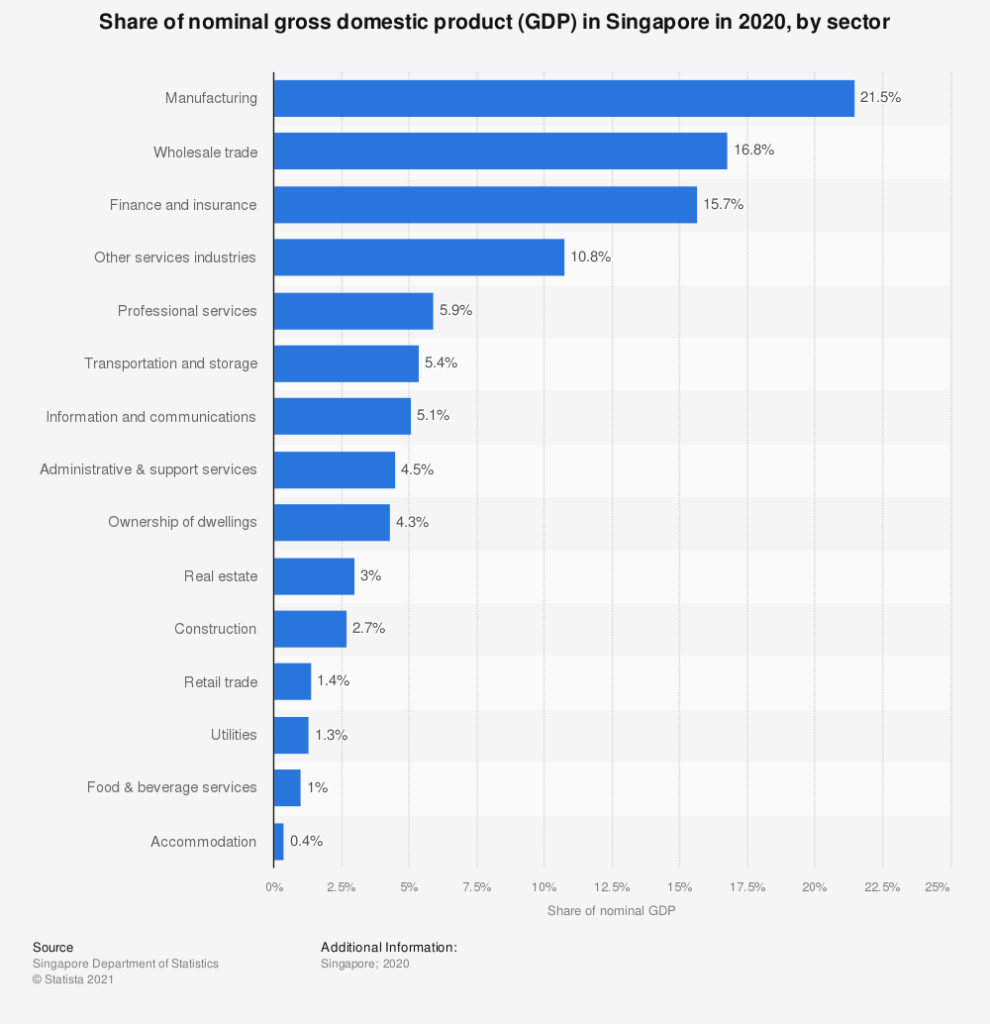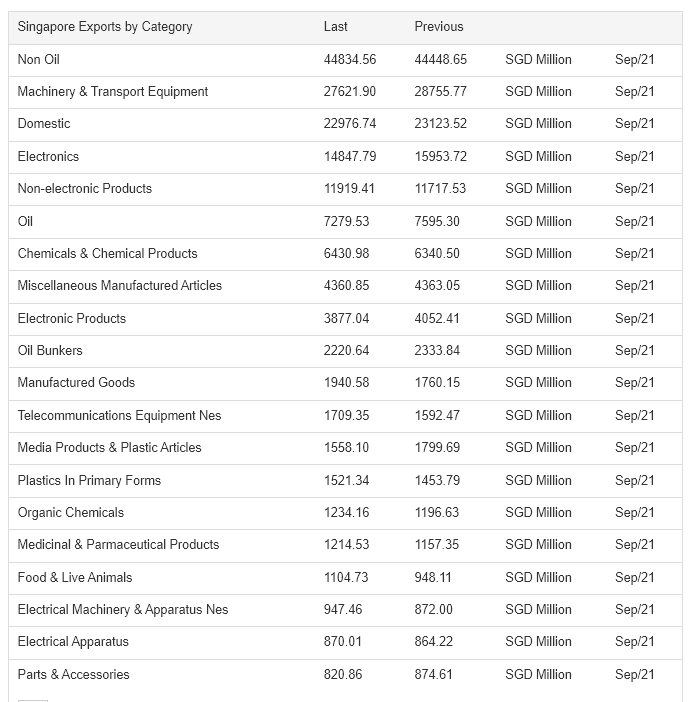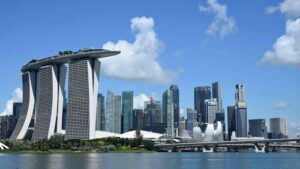If you found this post via search, it probably makes sense to start with the first post in this series. The link to the full series is above.
In this series of posts, I am examining seven specific nations that created economic value which transformed them from fairly poor countries to fairly rich countries.
This post focuses on Singapore.
Table of Contents
Background information
Geographically, Singapore is well situated at both the southern tip of Malaysia and the southern end of the Malaca Straight, a shipping channel between Malaysia and the Indonesian island of Sumatra.
This shipping channel was used for shipping between the Pacific ocean and the Indian ocean.
As such, the small island of Singapore looked like a strategic location for the British to set up a port, which they did in 1822.
The British expanded their presence in the area with the annex of Malaya in 1867.
During WW2, Singapore was attacked by Japanese forces and formally occupied by Japan starting in Feb of 1942.
When Japan surrendered in 1945, Singapore was handed over to the British Military Administration.
In 1946 Singapore became a British Crown Colony.
In 1963, the modern nation of Malaysia was formed, consisting of Malaya, Singapore, Sarawak, and North Borneo.
In August of 1965, Singapore separated from Malaysia to become an independent sovereign nation.
The government
There seems to be a general consensus that Singapore has had autocratic governments, but that for Singapore, that has worked out well.
- Singapore’s Lee Kuan Yew showed how autocratic government can be good government
- Singapore and the Limits of Authoritarian Prosperity
- Singapore’s Stubborn Authoritarianism
The focal point of this is a man named Lee Kuan Yew, who served as Prime Minister of Singapore from 1959 (before independence) to 1990.
He was a member of the People’s Action Party, which has ruled Singapore since independence in 1965.
Politics
Singapore has a UK-style parliamentary democracy, similar to many ex-colonies of the British empire.
The Wikipedia entry List of political parties in Singapore lists 15 political parties, only three of which currently have seats in parliament.
Of those three, the People’s Action Party has a very solid majority of 83 of the104 seats.
There is an executive branch, consisting of a President, but it seems to be a mostly ceremonial role, similar to the role of the Governor-General in Canada.
One interesting rule in Singapore politics is political association must not be affiliated or connected with any organization outside Singapore.
Government corruption
Government corruption in Singapore is considered to be amongst the lowest in the world, and definitely the lowest in Asia.
The article linked to above contains the following:
All countries have laws aimed at fighting corruption, but very few governments apply such laws as strictly and consistently as Singapore. Corrupt officials, particularly high-ranking ones, are dealt with in Singapore with a severity rarely seen elsewhere.
Straits Times, 1996: 3.
I found numerous articles on this subject, and the general agreement is Singapore has very effective anti-corruption laws, which are applied.
Transparency International is an organization that ranks nations on government corruption.
They rank Taiwan as the 3rd least corrupt government in the world.
The legal system
Check this out:
Singapore’s efficient, transparent and extremely sound legal system has been a key enabler for the country’s tremendous growth over the past few years.
GuideMeSingapore.com: Introduction to Singapore’s Legal System
And:
Singapore’s legal system is recognized for its fairness, integrity, and efficiency – making Singapore one of the best countries globally for starting and running a business.
CorporateServices.com: Singapore’s Legal System
As a former British colony, Singapore has a legal system based on English common law.
Singapore gets high marks for using that legal system to create a safe low-crime place to live.
The banking system
The central bank of Singapore is The Monetary Authority of Singapore. The currency they issue is the Singapore dollar.
As in almost all modern nations, Singapore has a fiat currency and a central bank that seeds a credit expansion banking system.
An IMF report published in 2013 states:
The Singapore financial system is highly developed, and well regulated and supervised.
and
Singapore’s current regulation and supervision are among the best globally.and
Bank regulation and supervision is of a high caliber….
To be clear, the report does not say there are no problems or areas for improvement.
The report does make a series of recommendations, but nothing as serious as you would expect to find in a banking system funding highly speculative activities, such as is found in the United States.
Healthcare
Singapore has universal healthcare funded via a mixed financing system.
There is a public statutory insurance company, MediShield Life, which covers large bills.
Smaller everyday expenses are not covered.
Patients pay premiums, deductibles, co-insurance, etc and is complemented by government subsidies as well as a mandatory medical savings account, called MediSave.
Natural resources
Singapore has little to no natural resources.
Direct government support and intervention
The Singapore government made decisions to directly support economic development through what they consider to be strategic investments.
Public housing
For a prosperous capitalist economy, Singapore has a long history of public housing.
In 1960, five years before independence, Singapore formed the Singapore Housing and Development Board (HBD) tasked with providing affordable high-quality housing for residents.
Today, in 2021, 80% of the population of Singapore lives in public housing.
It’s not a stigma in Singapore to live in public housing. It’s not just for poor people.
Employee training
They call it Human Capital Development.
As Singapore has no natural resources to speak of, they view Human Resources as something that must be developed.
The Singapore government manages a Skills Development Fund (SDF) which is used to finance employee training.
To be clear, the government of Singapore pays employers to train their employees.
There are rules as to what training they’ll pay for and for whom, but recognizing that a skilled workforce is a more valuable workforce, the government is willing to pay for this.
The SDF is funded by a skills development levy, which is tax specifically created for this purpose. Every employer pays a certain amount into the fund each month for each employee.
Government grants
The Singapore government provides grants (subsidies) to certain companies that meet certain conditions.
These grants are considered to be part of Singapore’s pro-business environment.
Manditory savings
I’m not sure this truly qualifies as direct government support of business, but it definitely deserves mention and it has to go in this post somewhere.
Employees in Singapore must save some of their income, by law.
All employees under 50 years of age MUST set aside 20% of their income. Employers must contribute another 16%.
These funds go into accounts for the individual, until some designated need arises for which the money can be withdrawn.
Valid reasons are: retirement, buying a home, paying for children’s education, and healthcare expenses.
Direct foreign investment
A number of companies have operations in Singapore.
The Wikipedia page on this topic lists 132 “notable” firms, some of which are native to Singapore. Most of which are not.
Bottom line… For a variety of reasons, multinational corporations see Singapore as a desirable place to do business.
Inflows of direct foreign investments were SGD $41.3 billion in 2021 Q2, which converts to USD $30.7 billion. In one quarter.
Important partnerships
The existence of the Singapore Future Economy Council (FEC) gives an overview of who they think matters in regards to the economic development and success of Singapore.
… the Council comprises members from government, industry, unions, and educational and training institutions.
It sounds like every group that should be represented is.
I find it especially interesting trade unions and training institutions have seats at the table.
GDP by sector
The largest industries in Singapore in 2020 were:

Exports by sector
In 2020 Singapore exported around $361B. The breakdown by sector is:

Wealth and income equality
The most widely used measure of income distribution is the Gini index. It condenses several data points into a single number from 0 (perfect equality) to 1 (perfect inequality), although it is sometimes expressed as a number between 0 and 100.
Singapore has a 2021 Gini index of 45.9, which ranks it as the 27th most unequal country on earth, which is not good considering 172 countries are rated.
For comparison, the Gini index of the United States is 41.1 (54th most unequal) and for Canada is 33.3 (127th most unequal).
In closing
Singapore seems to be, in my mind, an interesting mixture of democracy and authoritarianism, which the voters keep voting for.
However, that authoritarianism is perceived as helpful, not harmful, and as a result, the government has the ability to implement fairly strict policies on corruption, other forms of crime, and national savings, while simultaneously spending generously on public housing, employee training, and subsidies for businesses seen as strategic.



